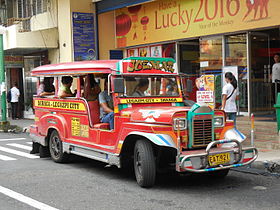Jeepney
| Jeepney | |
|---|---|
 |
|
| Overview | |
| Manufacturer |
|
| Production | 1945 - present |
| Assembly | Philippines |
| Designer | Leonardo Sarao |
| Body and chassis | |
| Class | Minivan, Minibus, Jeep |
| Body style | Multi-purpose vehicle |
| Layout | Front-engine, rear-wheel drive |
| Related | Jeep |
| Powertrain | |
| Engine | |
| Transmission |
|
Jeepneys, sometimes called simply jeeps, are the most popular means of public transportation in the Philippines. They are known for their crowded seating and kitsch decorations, which have become a ubiquitous symbol of Philippine culture and art. A Sarao jeepney was exhibited at the Philippine pavilion at the 1964 New York World's Fair as a national image for the Filipinos.
Jeepneys were originally made from U.S. military jeeps left over from World War II. The word jeepney may be a portmanteau word – some sources consider it a combination of "jeep" and "jitney", while other sources say "jeep" and "knee", because the passengers sit in very close proximity to each other. Most jeepneys are used as public utility vehicles. Some are used as personal vehicles. Jeepneys are used less often for commercial or institutional use.
When American troops began to leave the Philippines at the end of World War II, hundreds of surplus Jeeps were sold or given to the Filipinos. American Soldier, Harry Stonehill, was involved in the disposal of military surplus. He created a black market for the surplus including jeeps. The Jeeps were stripped down and altered locally: metal roofs were added for shade; and the vehicles decorated in vibrant colours with chrome-plated ornaments on the sides and hood. The back saloon was reconfigured with two long parallel benches with passengers facing each other to accommodate more passengers. The size, length and passenger capacity has increased as it evolved through the years. These were classified as passenger-type jeeps. The non-extended, original-seat configuration jeeps were labeled owners, short for owner-type jeeps, and are used non-commercially. The original Jeepneys were refurbished military Jeeps by Willys and Ford. Modern jeepneys are now produced with surplus engines and other parts coming from Japan.
...
Wikipedia
